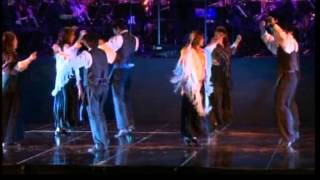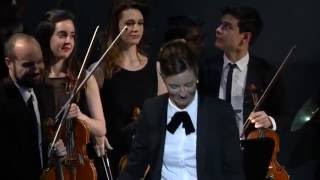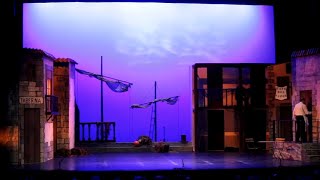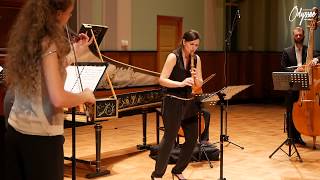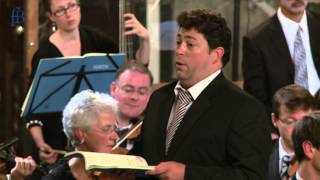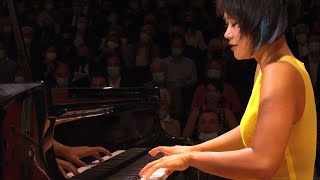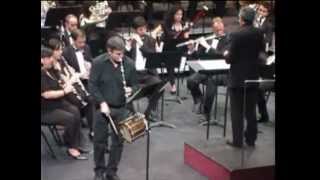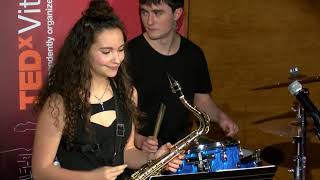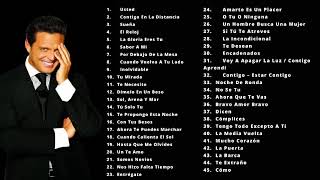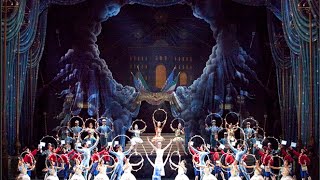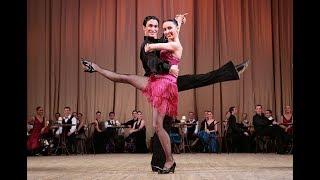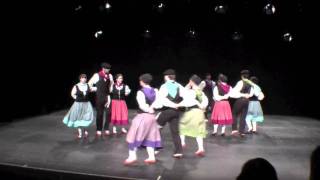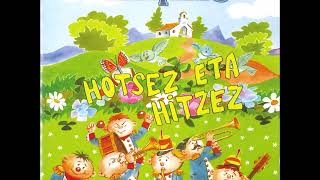The Virgen Blanca festivities of Vitoria-Gasteiz begin on August 4
Recommended music videos for initiation to classical music
The Festivities in honor of the Virgen Blanca have been celebrated in Vitoria-Gazteiz since 1884 and begin the day before, on August 4, in the Plaza de la Virgen Blanca , located in the heart of the city, where thousands of Vitorians and Visitors gather to start the festivities with the descent of Celedón . The celebration of celebrations in honor of the White Virgin dates back to very distant times; Until 1883, events were held that, under the name " Vitoria Festivals ", took place during the first week of September. Starting in 1884, after a municipal agreement, they began to be celebrated on August 5, in honor of the White Virgin . In 1953, the municipal corporation established the festive calendar as it is known today.
Life at the parties . The festivities begin with the descent of Celedón , a doll that represents an ancient Alava villager, and which crosses the Plaza through a system of pulleys; Upon arriving at the balcony of the Church of San Miguel , already transformed into a living member of a blouse gang, the traditional aurresku is danced to him. This is how the Festivities begin, which last from August 4 to 10, with the 5th being the Day of the White Virgin . The protagonists of these festivities are the blouse crews , groups of vitorians who, dressed in traditional costumes, organize and take part in numerous activities. Different shows, concerts and festivals are organized throughout the city and orchestras and brass bands circulate twenty-four hours a day.
José Luis Ruiz de Gordoa , author of the music of Badator Zeledon , is a composer and teacher born in Araia (Álava-Araba), on February 23, 1957. He began his musical studies at the Vitoria-Gasteiz Conservatory . He later continued those of harmony in Pamplona with Aurelio Sagaseta and Pedro de Felipe ; those of counterpoint and fugue in Bilbao with Juan Cordero , and those of composition, first in Madrid with Antón García Abril and Román Alís and then in Vitoria-Gasteiz , with Carmelo Bernaola . He has worked conducting with Enrique García Asensio . He is a professor of counterpoint and fugue at the Jesús Guridi Conservatory in Vitoria-Gasteiz and the author of various works of various genres. ( Extracted from Auñamendi Eusko Entziklopedia )
Pie tro Mascagni (1863-1945) was an Italian musician, one of the greatest exponents of verista opera. Mascagni 's most popular work is the opera Cavalleria Rusticana ; Written in just two months and based on a work by the Italian writer Giovanni Verga , it is an exponent of the Italian opera style called verismo, which emphasizes the real-life behavior of characters subjected to great emotional tension. The libretto is by G. Menasci and G. Targionni-Tozzetti , and it premiered in Rome in 1890. Among the 17 operas he composed, is Nerone (1935) which was a tribute to Benito Mussolini , since Mascagni had agreed to be the official musician of the fascist regime. He died at the Plaza de Roma hotel when, disillusioned, he was destitute.
Lara Diloy is one of the few Spanish conductors on the current circuit. She is the principal guest conductor of the Barbieri Symphony Orchestra and musical assistant for the Oviedo Opera Season . With extensive knowledge of the symphonic and operatic repertoire, he has worked on different symphonic and lyrical productions of the main orchestras in the State. She is the director and founder of the Sinan Kay white voice choir, winner of several national and international awards in recent years. In 2018 he received the YANMAG Award in recognition of his artistic career. Since its creation, he has been a member of the board of directors of AESDO (Spanish Association of Orchestral Directors), which was created as a meeting point between established conductors and the youngest ones.
Jelena Milojević is one of today's most prominent accordion players. He studied in both Croatia and Serbia and eventually received his Master's Degree in Accordion Performance and Education , at one of the most renowned accordion centers in the world, the Academy of Music (FILUM) in Kragujevac , Serbia. She is a winner of some of the most prestigious international accordion competitions, such as the CMA World Trophy, the International Accordion Competition in Castelfidardo, Italy, the International Accordion Competition in Pula, Croatia, the Roland V Accordion Competition , etc. and has performed with the Vancouver Symphony, Berlin Symphony, Aventa Ensemble, Turning Point Ensemble and Emily Carr String Quartet, UVic Choir and Orchestra , etc. (Extracted from the article by the Canadian University of Victoria) .
Dark Eyes ("Black Eyes". In Russian, Очи чёрные) is a Russian song, of the romance genre. Its lyrics were written by the Ukrainian poet and writer Yevhen Pavlovich Hrebinka (1812-1848), while the music comes from a waltz by the German Florian Hermann and its first publication known as a romanza (with words and music) was on March 7, 1884. Fyodor Chaliapin (prestigious Russian bass singer) added some verses to the original song and popularized the new version during a tour abroad. There are numerous versions of the song, such as the arrangement we offer today for accordion performed by Jelena Milojevic
Pablo Sorozábal (1897-1988) was born in Donostia/San Sebastián , according to his own memoirs, “into a proletarian, Basque-speaking family.” He began his violin studies at the San Sebastián Municipal Music Academy ; At the age of 17 he joined the San Sebastián Casino Orchestra and at the age of 21, the Madrid Philharmonic . With a scholarship from the Provincial Council of Gipuzkoa, he complements his studies in Leipzig and Berlin . Due to his republican ideas, after the Civil War , he was isolated as a composer, which made it difficult for him to premiere the different zarzuelas he composed in Madrid . As director of the Madrid Symphony Orchestra he ended up in bad shape in 1952 when he was prohibited from playing Shostakovich 's Leningrad Symphony , a fact that led to his resignation.
La tabernera del Puerto is a zarzuela in 3 acts with music by Pablo Sorozabal and libretto by Federico Romero and Guillermo Fernández-Shaw ; It was premiered on April 6, 1936 at the Tívoli Theater in Barcelona . The action takes place in the port of the imaginary city of Cantabreda . In the port is the Marola tavern; Nobody knows anything about its origin, it is only known that the tavern was paid for by the bandit Juan de Eguía , whom everyone believes to be her husband. Marola and Leandro fall in love and Marola confesses to Leandro that Juan de Eguía is her father, after which they will have to go through different vicissitudes.
Recommended classical music videos
Christoph Graupner (1683 - 1760) was a prolific German composer, famous for the excellent calligraphy of his autographs and copies. Graupner concludes his studies in Leipzig with Johann Kuhnau (1660-1722), Bach 's predecessor at St. Thomas Church . In 1705 he took the position of harpsichordist in the orchestra of the Hamburg Opera , in which Handel was a violinist. In 1709 he accepted a position at the court of Hesse-Darmstadt , becoming its conductor and composer in 1711. Graupner was one of the most esteemed composers of his time, like his contemporaries Handel, Telemann and Bach. His level of invention and originality stands out in his compositions; He was a lively, passionate, cultured man with great professional experience.
His works are cataloged with the initials GWV (Graupner Werke-Verzeichnis); Werke in German means "work" and Verzeichnis, "catalog."
Today the Dutch ensemble Ensemble Odyssee , with Anna Stegmann as soloist, offers us the Overture for recorder, strings and continuo GWV 447.
Franz Joseph Haydn (1732-1809), Austrian composer whose brother Michael Haydn was also a notable composer, was one of the main pillars on which classicism (1750-1810) was based. At six years of age he began his studies of harpsichord and violin. At the age of eight he was admitted as a choralist at St. Stephen's Cathedral in Vienna where he continued his musical studies. After changing his voice, he had to survive by working multiple jobs, while studying composition analyzing the works of Carl Philipp Emanuel Bach . He maintained a close friendship with Mozart and was Beethoven 's teacher. It laid the main foundations of the sonata form and the formal structure of the string quartet and the symphony . He died at the age of 77 in Vienna .
The catalog of Haydn's works . Joseph Haydn's works are classified today according to the system created by Anthony van Hoboken. Each work is identified with a Roman numeral that corresponds to the category, which in most cases corresponds to a genre. Some categories have subdivisions, which are indicated with a lowercase letter and then an Arabic number appears that corresponds to the order of the specific work within the category. These figures are preceded by the word Hoboken (in memory of the catalog's author) and sometimes by Hob .
Oratorio is a dramatic musical genre, unlike opera , without staging, costumes, or sets. Generally composed for solo voices, choir and symphony orchestra, sometimes with a narrator, its theme is frequently religious (stories from the Bible or the Gospel , the life of Jesus or the lives of saints, etc.), but can also be be profane (mythological heroes, historical themes, hymn to nature, etc.) as in the present case. Its main characteristics are generally A) A general structure in several parts, frequently three, (eventually preceded by an instrumental prelude). B) The presence of a narrator (external to the action or identified with a character). C) The alternation between the sung parts of arias and recitatives.
Die Schöpfung (The Creation) is an oratorio composed by Joseph Haydn between 1796 and 98 and premiered on April 29, 1798 in Vienna . The work illustrates the creation of the world, as narrated in Genesis . In addition to this book of the Old Testament , his sources of inspiration are the Psalms and Paradise Lost , by John Milton . Baron Gottfried Van Swieten was in charge of preparing the text. Its premiere took place in Vienna on April 19 and 30, 1798, obtaining a total success even greater than those obtained in England . A year later it premiered in Paris, London, Berlin and Prague , always with equal success. Since then, Haydn , as age and health permitted, directed an annual performance of the play in Vienna , usually for charity.
Structure . Creation is articulated in three parts. THE FIRST PART (2'05'') refers to the first four days of Creation; the SECOND PART (38'43''), on days five and six. Each day 's events for both parts unfold in a combination of recitative (a form of declamatory, voice-like singing that is free-rhythm) and aria (longer, more formal musical numbers), and each day ends with a chorus. The THIRD PART (1H 16'58'') focuses on the joy of Adam and Eve in the earthly paradise of the Garden of Eden . (Extracted from the La Phil article).
Today we can see it thanks to the baton of the German maestro Philipp von Steinaecker .
Sergei Rachmaninoff (1873-1943) was a Russian pianist, conductor and composer born into an aristocratic family of musicians; He began playing the piano at the age of four, formalizing his studies at the Saint Petersburg Conservatory and later at the Moscow Conservatory. After the premiere of his First Symphony and the criticism received, he suffered a creative crisis for four years. Once surpassed, he wrote the Piano Concerto No. 2 , which received worldwide recognition and fame. After the Russian Revolution, he moved with his family to Switzerland and, in 1935, to the USA, writing numerous works for solo and concert piano, chamber music, symphonic and lyrical music. He is considered one of the most influential pianists of the 20th century and one of the most representative composers of Russia .
Catalog of Rachmaninoff 's works . His works are classified by their Opus number (from the Latin opus 'work'; op. abbreviation) which is a term used in music to catalog the works of most composers since the 17th century .
The Piano Concerto No. 2 , Op. 18 in C minor, is a piece composed for piano and orchestra by Sergei Rachmaninov between the autumn of 1900 and April 1901. The complete work was premiered on October 27, 1901 with the composer as soloist and his cousin Aleksandr Ziloti as soloist. the baton It is articulated in three movements: I (0´07´´) MODERATO .-. II (10´50´´) ADAGIO SOSTENUTO .-. III (22´00´´) ALLEGRO SCHERZANDO.
Today it is offered to us by the international Chinese pianist Yuja Wang accompanied by the Mariinsky Theater Orchestra conducted by the renowned Russian maestro Valery Gergiev .
Hilario Extremiana (1958) is a composer and conductor born in Miranda de Ebro and based in Vitoria-Gazteiz . He began his musical studies with his father and Manuel Celdrán . He later studied Harmony and Composition in Vitoria with Carmelo Bernaola , and in Bilbao with Juan Cordero . In special courses he has also trained with Cristóbal Halffter, Luis de Pablo and Franco Donatoni. In Madrid he completed his higher studies in Composition with Antón García Abril and those in Orchestral Conducting with Enrique García Asensio . He has been a professor of Harmony, Musical Forms and Director of the Orchestra of the Superior Conservatory of Bilbao and from 1999 to 2019 Principal Conductor of the Municipal Music Band of Vitoria-Gasteiz .
The Txistu is a musical instrument that belongs to the European family commonly known as the “Three-hole Flute”. It is played with only one hand (normally the left), so that the other is free to play the drum that hangs from the arm used to play the txistu . Currently tuned in F , it is frequently accompanied by the whistle or txistu haundi , a lower instrument, tuned in Bb . The txirula , a higher-pitched instrument, belongs to the same family, which is usually accompanied by the ttun ttun (string drum). The txistu is used in pilgrimages, parades, tributes, institutional events and in different types of concerts both as a solo instrument accompanied by an orchestra, and as a small band of txistus , in which case the works are usually written for three voices (txistu 1st , txistu 2nd and whistle) with accompaniment of the tambourine and the clear box, atabal or snare drum.
Today the txistulari Aitor Amilibia offers us the work Honai by Hilario Extremiana (a piece originally written for txistu and accordion and transcribed for txistu and Music Band by the same author) accompanied by the Vitoria-Gasteiz Municipal Music Band conducted by maestro Extremiana , author of the composition.
Recommended music videos for all tastes
Combo Y 25 is a jazz combo from the Jesús Guridi Conservatory , in Vitoria-Gasteiz (Araba), made up of Iñar Sastre (pianist, repertoire teacher at the Conservatory, and creator of this Combo ), Martina González de Langarica (saxophone student ), Axel Yong Ortiz (electric guitar student) and Julen Ortiz de Zárate (percussion student). The nickname Y 25 is due to the fact that when the students had the Combo class with their teacher, Inar , he arrived “punctually”… twenty-five minutes later. To date, Combo Y 25 has had two performances at the Fundación Vital concert venue and another two at the Jesús Guridi Conservatory with works such as I got rhythm , by George Gershwin , Yes or no , by Whaine Shorter , or Misty , by Errol Garner .
Edyta Górniak (November 14, 1972) is a Polish pop singer and one of the most recognized voices in the history of her country's music. Górniak possesses a wide vocal range of approximately four octaves. She represented Poland in the Eurovision Song Contest in 1994 with the single To nie ja . She was born in Ziębice and from the age of 6 she lived in Opole , where she was a student of Elżbieta Zapendowska , head teacher of young vocal soloists. Likewise, Edyta attended the Studiu Buffo academy in Warsaw . After forming a band at the age of 14 with which he performed at parties and private celebrations, his professional career as such began when in 1989 he participated in the television program Śpiewać każdy może (Everyone can sing), which he won with Sam 's famous song. BrownStop .
Luis Miguel Gallego Basteri (San Juan, Puerto Rico, April 19, 1970) is a Mexican singer and producer. Recognized for his powerful voice and stage presence, he is one of the most successful singers in Spanish music. He has sold around 100 million records worldwide, and has sung in multiple genres and styles, including pop songs, ballads, boleros, tangos, jazz, big band and mariachi . He is also recognized as the only Latin singer of his generation who did not cross over into the Anglo-Saxon market during the "Latin explosion" in the 1990s and, on the contrary, remained the best-selling artist in that decade. He began his career in 1981, at the age of eleven, and at fourteen he won his first Grammy Award, becoming the youngest male artist in music history to receive said award. Since then, he has won six Grammy Awards and another six Latin Grammy Awards. In addition, he has won fourteen Billboard Latin Music Awards, three World Music Awards , twelve Lo Nuestro Awards , five Spotify Awards, among many others. In 1991, his album Romance became one of the best-selling Spanish-language albums of all time, with 14 million copies.
Elisa Toffoli (Trieste, Friuli-Venezia Giulia; December 19, 1977) is an Italian singer-songwriter. Since his childhood, he showed great sensitivity in the arts: he danced, painted, acted, and wrote stories; Still, the natural evolution of his talent reveals itself primarily in music. When he was only eleven years old, he began to write his first lyrics and melodies. A few years later, her attitude toward music exploded, and Elisa began performing with various local bands. It was a path of no return. He achieved greater popularity after his participation in the 2001 San Remo festival, with his song in Italian Luce (tramonti a nord est). His musical repertoire varies across various musical genres, writing and performing especially rock, blues, soul and ambient . She is considered one of the most beautiful and skilled voices on the Italian musical scene, distinguished by the particularity of her falsetto.
Recommended peculiar videos
Romualdo Marenco (1841-1907) was an Italian composer known primarily for his ballet music. Marenco began his musical career as a violinist at the Teatro Doria in Genoa . His first composition was the ballet Garibaldi's Landing in Marsala . He was appointed conductor of La Scala in Milan and also directed its ballet company for seven years. His best-known ballets were written in collaboration with choreographer Luigi Manzotti during that period; but above all he is remembered for the ballet Excelsior , composed in 1881 and which we offer today.
The Excelsior Ballet is a tribute to the scientific and industrial progress made throughout the 19th century , from the electric light to the telegraph, the steam engine, the Fréjus railway tunnel and the Suez Canal . As such, it foreshadows the futurist movement. In the first nine months, it was performed 100 times in Italy and abroad.
Tango is a musical genre and dance characteristic of the Río de la Plata region and its area of influence, but mainly of the cities of Buenos Aires (in Argentina) and Montevideo (in Uruguay). Six main musical styles left their mark on tango: the Andalusian tango, the Cuban habanera, the candombe, the milonga, the mazurka and the European polka . Tango revolutionized popular dance by introducing a sensual dance with an embraced couple that proposes a deep emotional relationship between each person with their own body and the bodies of the dancers with each other. Musically, it usually has a binary form (theme and chorus) or ternary (two parts to which a trio is added). On September 30, 2009, UNESCO declared it Intangible Cultural Heritage of Humanity.
Igor Moiseyev (1906-2007) was a Russian choreographer and dancer who studied at the Bolshoi Theater Ballet , a company with which he worked and even directed acrobatic dances in Moscow's Red Square until the Government put him under his control in 1930. He directed a new dance company called Ballet Igor Moiseyev with which he would prepare nearly 200 choreographies. Currently the Igor Moiseyev Ballet is one of the great ballet companies in the world that manages to synthesize the spontaneity of popular dances with the academicism of classical ballet.
Today we can enjoy it in this florilegium of Argentine tangos that this video offers us.
Bollywood is the name used for the Hindi-language film industry, located in Bombay , the most populated city in India . The term, coined in the 1970s, comes from a play on words between " Bombay " and " Hollywood ", the center of the US film industry. The group formed by Bollywood and filming in languages such as Marathi, Tamil, Telugu, Bengali, Kannada (Kannada) and Malayalam , constitute the core of the Indian film industry, in which Bollywood is a fundamental piece.
The most representative characteristic of Bollywood films are their musical scenes; Generally, each film includes typical songs and dances from the country, mixed with curious Western pop choreographies. Today we offer a series of these scenes.
Algara Dantza Taldea was born on April 13, 2000. At first it was made up of 15 dantzaris from another dantza group. Today there are 120 dancers and 20 musicians. Its objective is to make Basque dances and culture known. To do this, they create their own choreographies and dance them to the sound of the trikitixa, the txistu, the alboka and many other instruments. (Extracted from Ohianeder Euskararen Etxea)
Fandango and Arin Arin. It is a dance performed either as a couple, as a trio of dancers, whether two men and a woman or vice versa, or in a circle. It is, therefore, a social and mixed dance in the sense that it is performed in society and both sexes take part. According to various researchers, it could be an import of the style of dancing typical of the Peninsular South which, closer to the culture we call Arab, prioritizes the movement of the arms and hands over that exercised by the legs. The arms are raised, forming an angle in front of the eyes and with the shoulders of the dancers, a rare occurrence in Biscayan dances. (Extracted from EuskalHerriko Dantzak)
Recommended music videos for children
Various Wikipedia articles have been used to write these texts.
The texts of Videomusicalis are written in Basque, Spanish and English.





